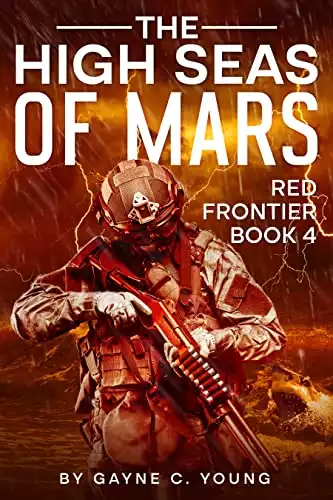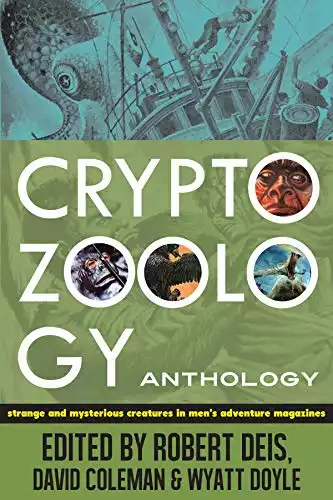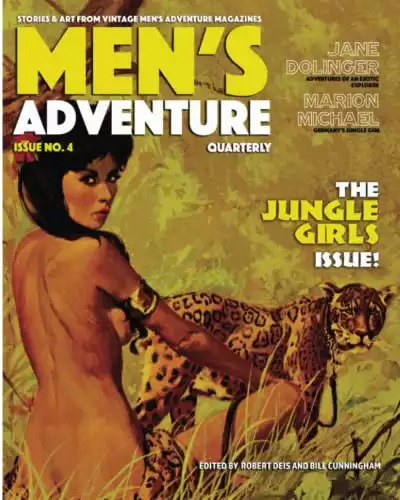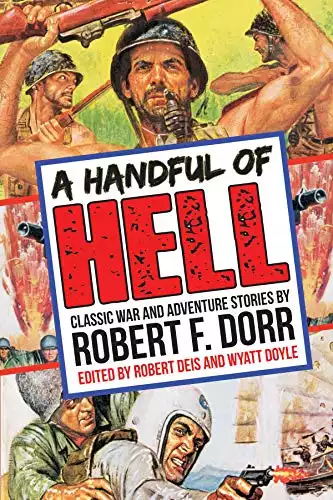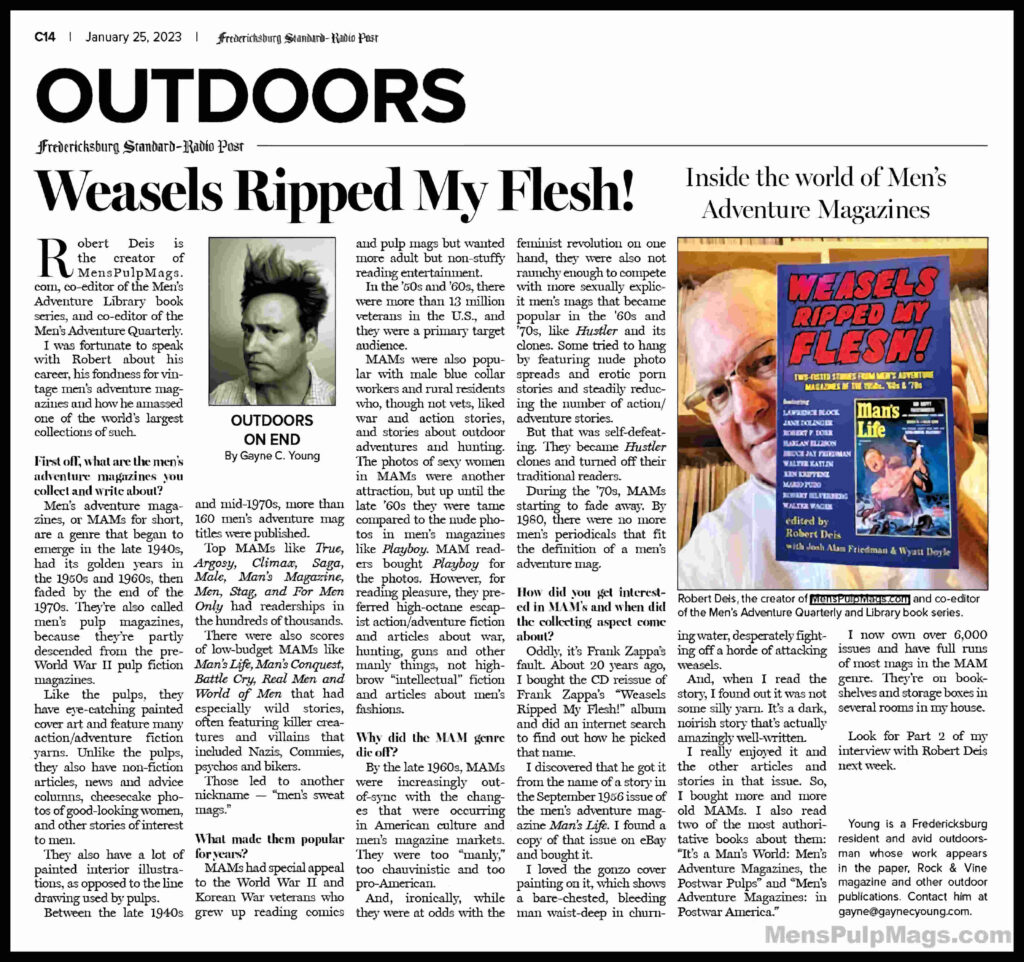
A while back, I connected with writer Gayne C. Young via the Men’s Adventure Magazines & Books Facebook Group.
Gayne is a prolific action/adventure and science fiction author whose books I admire and enjoy.
Most recently, I read the fourth novel in Gayne’s gritty “Red Frontier” sci fi series, THE HIGH SEAS OF MARS and one of his excellent cryptozoology-related novels, BIGFOOT: THE VIETNAM DEFENSIVE DECLASSIFIED.
Like all of Gayne’s novels, they are high octane, bloody and bloody interesting reads and I gave them 5-star reviews on Amazon and Goodreads.
I gotta admit, I’m a bit in awe of Gayne. In addition to being a terrific novelist, he has been an editor for NORTH AMERICAN HUNTER and NORTH AMERICAN FISHERMAN (both part of CBS Sports), a regular contributor to top outdoor sports magazines, such as SPORTING CLASSICS, OUTDOOR LIFE, SPORTS AFIELD, and a newspaper columnist.
Gayne’s in-depth knowledge of hunting, cryptozoology monster lore and guns is reflected in his fiction as well as his non-fiction. For example, he has carved out a unique writing niche in the realm of cryptozoology by penning a series of novels that combine military action/adventure with crypto creatures.

His book BIGFOOT: THE VIETNAM DEFENSIVE DECLASSIFIED is a prime example. Set during the Vietnam War, it follows an American special forces team sent on a classified mission into the jungles of Cambodia to find out what happened to another squad who disappeared there. The novel is said to be “inspired by true events” and—as cryptozoology buffs who read the book will know—it is indeed inspired by the tales of Bigfoot-like “rock apes” American soldiers reported seeing in Vietnam.
It’s a fast-paced, vividly written tale that gets your attention right from the start with these intense opening lines: “The creature drove its teeth into Hamilton’s nose. The monstrous incisors cut through skin, lacerated cartilage, and severed muscle. The beast’s more than two-inch-long canines plowed downward and scraped jawbone. The unknown reared back taking with it a mouthful of flesh, soft tissue, and bone.”
And, that’s just a small, er, taste of what’s to come in the chapters that follow.
During the past year, I’ve also gotten hooked on Gayne “Red Frontier” science fiction novels. That series is set on a future Mars that has been terraformed and settled by humans, but remains wild and full of dangerous animals and people.
Gayne’s Mars is not a romantic Edgar Rice Burroughs style Mars. It has the darker, bloodier, more violent flavor of modern military sci fi and action/adventure novels, and a vision of Mars that is as well-imagined as Burroughs’ but completely different and much grittier.

In addition to writing novels and magazine articles, Gayne writes a weekly column for the Fredericksburg Standard newspaper in his home state of Texas. And, early in 2023, he asked me if I’d do an interview with him about the Men’s Adventure Library book series I co-edit with Wyatt Doyle and the MEN’S ADVENTURE QUARTERLY magazine I co-edit with Bill Cunningham. I was honored and emailed him answers to a set of questions he asked me.
This Q&A was published in two parts in his Fredericksburg Standard column. With Gayne’s permission, I have reprinted the entire Q&A below.
GAYNE: First off, what are the men’s adventure magazines you collect and write about?
Men’s adventure magazines, or MAMs for short, are a genre that began to emerge in the late 1940s, had its golden years in the 1950s and 1960s, then faded by the end of the 1970s. They’re also called men’s pulp magazines, because they’re partly descended from the pre-World War II pulp fiction magazines. Like the pulps, they have eye-catching painted cover art and feature many action/adventure fiction yarns. Unlike the pulps, they also have non-fiction articles, news and advice columns, cheesecake photos of good-looking women, and other stories of interest to men.
They also have a lot of painted interior illustrations, as opposed to the line drawing used by pulps. Between the late ‘40s and mid-1970s, more than 160 men’s adventure mag titles were published. Top MAMs like TRUE, ARGOSY, CLIMAX, SAGA, MALE, MAN’S MAGAZINE, MEN, STAG, and FOR MEN ONLY had readerships in the hundreds of thousands. There were also scores of low-budget MAMs like MAN’S LIFE, MAN’S CONQUEST, BATTLE CRY, REAL MEN and WORLD OF MEN that had especially wild stories, often featuring killer creatures and villains that included Nazis, Commies, psychos and bikers. Those led to another nickname—“men’s sweat mags.”

GAYNE: What made them popular for years?
BOB: MAMs had special appeal to the World War II and Korean War veterans who grew up reading comics and pulp mags but wanted more adult but non-stuffy reading entertainment. In the ‘50s and ‘60s, there were more than 13 million veterans in the U.S., and they were a primary target audience. MAMs were also popular with male blue collar workers and rural residents who, though not vets, liked war and action stories, and stories about outdoor adventures and hunting.
The photos of sexy women in MAMs were another attraction, but up until the late ‘60s they were tame compared to the nude photos in men’s magazines like PLAYBOY. MAM readers bought PLAYBOY for the photos. However, for reading pleasure, they preferred high-octane escapist action/adventure fiction and articles about war, hunting, guns, and other manly things, not highbrow “intellectual” fiction and articles about men’s fashions.
GAYNE: Why did the MAM genre die off?
BOB: By the ‘late 1960s, MAMs were increasingly out-of-sync with the changes that were occurring in American culture and men’s magazine markets. They were too “manly,” too chauvinistic and too pro-American. And, ironically, while they were at odds with the feminist revolution on one hand, they were also not raunchy enough to compete with more sexually explicit men’s mags that became popular in the ‘60s and ‘70s, like HUSTLER and its clones. Some tried to hang by featuring nude photo spreads and erotic porn stories and steadily reducing the number of action/adventure stories. But that was self-defeating. They became Hustler clones and turned off their traditional readers. During the ‘70s, MAMs starting to fade away. By 1980 there were no more men’s periodicals that fit the definition of a men’s adventure mag.

GAYNE: How did you get interested in MAM’s and when did the collecting aspect come about?
BOB: Oddly, it’s Frank Zappa’s fault. About 20 years ago, I bought the CD reissue of Frank Zappa’s “Weasels Ripped My Flesh!” album and did an internet search to find out how he picked that name. I discovered that he got it from the name of a story in the September 1956 issue of the men’s adventure magazine MAN’S LIFE. I found a copy of that issue on eBay and bought it. I loved the gonzo cover painting on it, which shows a bare-chested, bleeding man waist-deep in churning water, desperately fighting off a horde of attacking weasels. And, when I read the story, I found out it was not some silly yarn. It’s a dark, noirish story that’s actually amazingly well written. I really enjoyed it and the other articles and stories in that issue. So, I bought more and more old MAMs. I also read two of the most authoritative books about them: IT’S A MAN’S WORLD: MEN’S ADVENTURE MAGAZINES, THE POSTWAR PULPS and, MEN’S ADVENTURE MAGAZINES: IN POSTWAR AMERICA. I now own over 6,000 issues, and have full runs of most mags in the MAM genre. They’re on bookshelves and storage boxes in several rooms in my house.
GAYNE: How did you get into writing about MAMs and publishing books about them?
BOB: About 15 years ago, I realized there was no website that focused on MAMs, so I decided to create one, my MensPulpMags.com blog. As a result of that, I was contacted by a number of other fans of the genre and by some of the living writers and artists who worked for MAMs. In 2013, I hooked up Wyatt Doyle, a MAM fan who owns the indie publishing company New Texture.

We had noticed that many anthologies of pre-WWII pulp mag stories were being published, as well as books featuring pulp mag artwork, but nobody was reprinting old MAM stories and artwork. We decided to publish a MAM story anthology to see if it would sell. We titled it WEASELS RIPPED MY FLESH! and included that story in the book. It sold well, so Wyatt and I launched a series of books featuring MAM stories and artwork we call the Men’s Adventure Library series. There are 13 books in the series to date, and more coming this year. In 2021, I also launched a magazine called the MEN’S ADVENTURE QUARTERLY with Bill Cunningham, head of Pulp 2.0 Press. We’ve published seven MAQ issues so far.
GAYNE: What are some of your favorite MAM stories, besides the killer weasels yarn?
BOB: I have lots of favorites, so it’s hard to choose. But, like the weasels story, some of my other faves have ended up inspiring books. For example, another man vs. animal story I like a lot is “I Watched Them Eat Me Alive!” In it, a wounded man marooned on a beach watches himself get eaten by big Coconut Crabs. Wyatt and I included that one in our anthology of MAM killer creature stories and artwork we titled I WATCHED THEM EAT ME ALIVE!
I’m also a big fan of MAM war stories. One of my favorites is about a serviceman who saves the life of his fellow B-29 crew members during a mission in World War Two. He picks up an incendiary bomb that goes off prematurely, carries it as it burns the flesh off his body, and throws it out of the plane. That gripping story was written by a top MAM writer named Robert F. Dorr. We included it and other MAM war stories in our book A HANDFUL OF HELL! I‘m also partial to stories about Bigfoot, Sasquatch and other legendary monsters. We reprinted a bunch of those in our book, the CRYPTOZOOLOGY ANTHOLOGY. One is a classic story by Arthur C. Clarke that I love, called “The Reckless Ones.” It’s about a giant squid and it’s brimming with sly humor.
GAYNE: Who are some of the writers that most people would be surprised to learn started out in MAM’s?
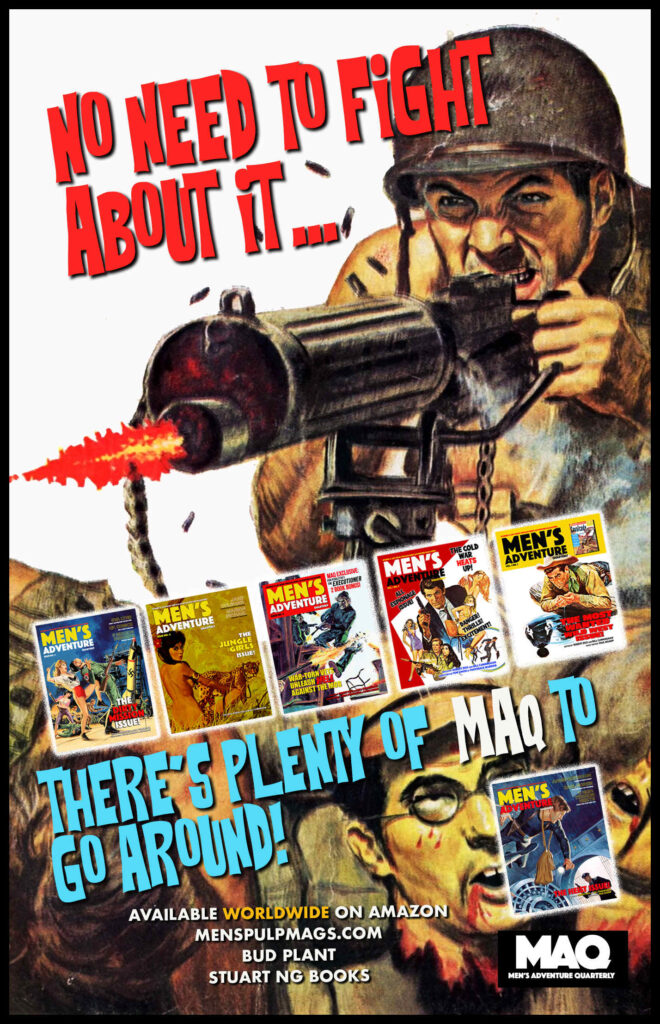
BOB: Most people don’t know that MAMs were a primary outlet for stories written by many top action/adventure, crime and thriller authors of the mid-20th Century, and for condensed “Book Bonus” of their novels. Writers like Lawrence Block, Harlan Ellison, Mario Puzo, Robert Silverberg, Robert Ruark, Donald Westlake, Martin Cruz Smith, Walter Wager, Don Pendleton, and many more. We recently published a collection of MAM stories by Silverberg and have an anthology of Block’s MAM stories coming out soon.
I should note that MAMs also used cover and interior artwork by many of the greatest illustration artists of the era. Artists like Mort Künstler, James Bama, Gil Cohen, Frank McCarthy, Charles Copeland, Robert Maguire, James Meese, Robert McGinnis, Samson Pollen, John Schoenherr, Robert Schulz, Robert Stanley—the list goes on and on. We’ve done several books featuring MAM artwork, rather than stories, most recently a book showcasing MAM covers by the great George Gross, titled GEORGE GROSS: COVERED.
GAYNE: Is it difficult to market books featuring old MAM stories with sex, violence, scantily clad women and other politically incorrect stuff?
BOB: Well, the books and the magazine I co-edit are obviously not intended for overly woke readers or even for most mainstream readers. But luckily there is still a niche market made up of men and some women who enjoy over-the-top action and adventure stories and cool illustration artwork. I suspect many are the same kind of people who read the type of action/adventure novels you write, which I am also a fan of. We link up with a lot of those people via social media, through things like my MensPulpMags.com blog and the Men’s Adventure Magazines & Books Facebook Group. And, once someone gets into MAM stories and artwork, they usually buy more of the books I co-edit and issues of the MEN’S ADVENTURE QUARTERLY.
Thanks again to Gayne for the interview—and for the enjoyment his novels give me. Stay Squatchy, my friend!
* * * * *
Comments? Corrections? Questions? You can click the CONTACT tab and email them to me,
or join the Men’s Adventure Magazines & Books Facebook Group and post them there.
RELATED READING…






